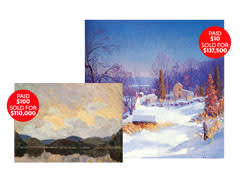How much is your stuff worth?


Before your next tag sale, get an appraisal so you don’t end up giving away treasures.
Imagine selling a painting at a yard sale for $10, then learning the buyer later sold it at auction for $137,500. You’d want to kick yourself.
A discovery that big isn’t common, says Alasdair Nichol, vice chairman at Freeman’s Auctioneers & Appraisers, the Philadelphia-based auction house that in 2004 sold the painting—a winter landscape by the Pennsylvania impressionist Kenneth Nunamaker (shown far right; the other painting shown, by Tom Thomson, was bought for only $100 and then sold for $110,000). But Nichol, a featured appraiser on the PBS program "Antiques Roadshow," says smaller surprises happen often enough. "You frequently get people bringing in something that they bought for $5 that’s worth $3,000 to $4,000," he says.
Whether you want to know an item’s value for a sale, insurance coverage, estate valuation, a charitable donation, or just to satisfy your curiosity, it’s often worth spending some time and money to find out. Here are resources to help you proceed.
[More from Consumer Reports: Top electronic products]
Professional appraisals. You can find an appraiser for almost any item, whether it’s an antique Greek vase or a Richard Simmons autograph. The key is finding one who’s accredited and meets professional and ethical standards.
An appraiser’s written report should include a full description of your item and the procedure used to estimate its current value. (Fair-market value is what a buyer would pay you; replacement value is what it would cost today at retail.) Appraisers might charge a flat fee or an hourly rate from $200 to $400 depending on their expertise and location, says Nancy Harrison, president of the Appraisers Association of America, in New York. Avoid an appraiser who asks for a fee based on a percentage of the item’s value.
Harrison recommends seeking a certified appraiser’s valuation before taking the item to a local antiques or collectibles dealer. An appraiser is more likely to give a fair judgment because there’s no conflict of interest; it’s a violation of professional ethics to offer to buy an item he has appraised. If an appraiser thinks an object isn’t worth a written appraisal, she might recommend other resources to arrive at a value.
Auction houses, such as Sotheby’s and Christie’s, periodically provide free, oral valuations to the public. Search on their websites for "valuation day" or "appraisal day." To have an item appraised on "Antiques Roadshow," you’ll need a ticket to an appraisal event.
[More from Consumer Reports: Appliance ratings and reviews]
Price guides. Many collectibles have well-established guidebooks. There’s "A Guide Book of United States Coins," for example, and the "Scott Standard Postage Stamp Catalogue." Two baseball-card sources are "The Standard Catalog of Baseball Cards" and the "Beckett Almanac of Baseball Cards & Collectibles." "Kovels’ Antiques & Collectibles Price Guide" reports on recent prices paid for items in more than 700 categories at auctions, shops, shows, flea markets, and online.
Online valuations. Several websites offer estimates by professional appraisers and other experts in areas as diverse as antique furniture, political memorabilia, and Barbie dolls. You upload photos of your items and provide descriptions; the sites send back valuations, not authentications, usually within a week.
What’s It Worth to You charges a minimum of $10 to value a single item. Its appraisers can also provide opinions on how much something on eBay is worth. Value My Stuff also charges $10 per appraisal. WorthPoint valuations start at $30 an item; you can also pay $10 or more for a monthly membership that provides access to a database of sales records and instant valuations or price lookups. A free introductory week is available.
To find the tax-deductible value of donated items, check out the free valuation sites available year-round by tax-prep companies, such as Turbo Tax’s ItsDeductible Online and H&R Block’s DeductionPro. The Salvation Army also offers a valuation guide.
Databases and online auctions. Kovels offers a free subscription to its antiques price guide and two premium services, at $39 and $60 a year. Craigslist is useful for seeing what others are willing to pay for similar items. Prices on eBay give you a more global view, but the downside is that if you plan to sell there, you’ll probably get only the wholesale price.
[More from Consumer Reports: Best & worst new cars]
How to find an appraiser
You can search online by specialty and location for appraisers who belong to these professional organizations.
American Society of Appraisers has almost 5,000 members worldwide. Among its disciplines is personal property, including African sculpture and violins.
Appraisers Association of America has more than 500 members worldwide. Most specialize in fine and decorative arts, jewelry, and household contents.
International Society of Appraisers has about 900 members, mostly in North America, who specialize in personal property.
Consumer Reports has no relationship with any advertisers on Yahoo!
Copyright © 2008-2012 Consumers Union of U.S., Inc. No reproduction in whole or in part without written permission.
More From Consumer Reports

